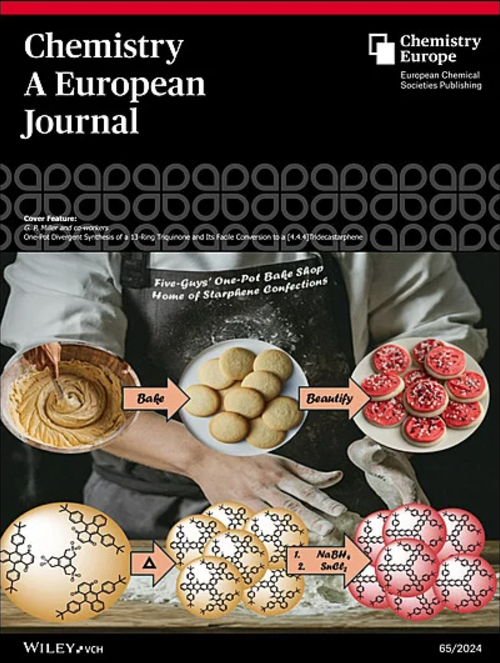封面专题:揭示最小二茂铁配合物的双重性质
IF 3.9
2区 化学
Q2 CHEMISTRY, MULTIDISCIPLINARY
引用次数: 0
摘要
旋转光谱和计算化学揭示了二茂铁-水配合物的轴向和赤道结合基序。对于轴向排列,二维能量面显示出类似墨西哥帽的势,允许水分子几乎自由旋转。中等强度的结合相互作用微妙地扭曲了二茂铁的框架。更多信息可以在j.c. López及其同事的研究文章中找到(DOI: 10.1002/chem.202500128)。本文章由计算机程序翻译,如有差异,请以英文原文为准。
Cover Feature: Unveiling the Dual Nature of the Smallest Aqueous Ferrocene Complex
Rotational spectroscopy and computational chemistry reveal axial and equatorial binding motifs in a ferrocene–water complex. For the axial arrangement, a two-dimensional energy surface displays a Mexican hat-like potential, allowing nearly free rotation of the water molecule. Moderately strong binding interactions subtly distort the ferrocene framework. More information can be found in the Research Article by J. C. López and co-workers (DOI: 10.1002/chem.202500128).
求助全文
通过发布文献求助,成功后即可免费获取论文全文。
去求助
来源期刊

Chemistry - A European Journal
化学-化学综合
CiteScore
7.90
自引率
4.70%
发文量
1808
审稿时长
1.8 months
期刊介绍:
Chemistry—A European Journal is a truly international journal with top quality contributions (2018 ISI Impact Factor: 5.16). It publishes a wide range of outstanding Reviews, Minireviews, Concepts, Full Papers, and Communications from all areas of chemistry and related fields.
Based in Europe Chemistry—A European Journal provides an excellent platform for increasing the visibility of European chemistry as well as for featuring the best research from authors from around the world.
All manuscripts are peer-reviewed, and electronic processing ensures accurate reproduction of text and data, plus short publication times.
The Concepts section provides nonspecialist readers with a useful conceptual guide to unfamiliar areas and experts with new angles on familiar problems.
Chemistry—A European Journal is published on behalf of ChemPubSoc Europe, a group of 16 national chemical societies from within Europe, and supported by the Asian Chemical Editorial Societies. The ChemPubSoc Europe family comprises: Angewandte Chemie, Chemistry—A European Journal, European Journal of Organic Chemistry, European Journal of Inorganic Chemistry, ChemPhysChem, ChemBioChem, ChemMedChem, ChemCatChem, ChemSusChem, ChemPlusChem, ChemElectroChem, and ChemistryOpen.
 求助内容:
求助内容: 应助结果提醒方式:
应助结果提醒方式:


